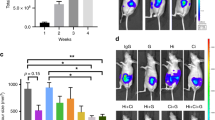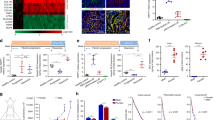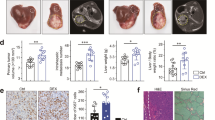Abstract
Gallbladder cancer cells are stimulated by hepatocyte growth factor (HGF) in vitro and in vivo. We constructed an adenovirus vector, AdCMV.NK4, carrying the HGF antagonist HGF/NK4 (NK4) and evaluated whether or not this vector can suppress the peritoneal implantation of gallbladder cancer in a novel peritoneal injury mouse model. A human gallbladder cancer cell line (GB-d1) and human peritoneal mesothelial cells infected with the adenovirus vector produced a substantial level of NK4 protein. An invasion of GB-d1 cells was determined by a coculture with AdCMV.NK4-infected human mesothelial cells in vitro. Both the invasion and migration of GB-d1 cells were dramatically inhibited by this vector in a multiplicity of infection (MOI)-dependent manner. GB-d1 cells were intraperitoneally injected into the nude mice with peritoneal injury, followed by either AdCMV.NK4 or a control vector (AdCMV.LacZ). The incidence and the size of the metastatic tumor drastically decreased by AdCMV.NK4 (MOI 100: n=4, P<.0001). Real-time PCR analysis revealed a transient elevation of mouse HGF mRNA expression at the peritoneal injury sites. AdCMV.NK4 has been suggested to induce the inhibition of the implantation and growth of gallbladder cancer cells in vivo through its anti-HGF activity, and the use of NK4 gene transfer could be an effective modality for preventing peritoneal metastasis of gallbladder cancer.
This is a preview of subscription content, access via your institution
Access options
Subscribe to this journal
Receive 12 print issues and online access
$259.00 per year
only $21.58 per issue
Buy this article
- Purchase on Springer Link
- Instant access to full article PDF
Prices may be subject to local taxes which are calculated during checkout






Similar content being viewed by others
References
Henson DE, Albores-Saavedra J, Corle D . Carcinoma of the gallbladder. Cancer. 1992;70:1493–1497.
Donohue JH, Nagorney DM, Grant CS, et al. Carcinoma of the gallbladder: does radical resection improve outcome? Arch. Surg. 1990;125:237–241.
Takada T, Nimura Y, Katoh H, et al. Prospective randomized trial of 5-fluorouracil, doxorubicin, and mitomycin C for non-resectable pancreatic and biliary carcinoma: multicenter randomized trial. Hepatogastroenterology. 1998;45:2020–2026.
Nakamura T, Nawa K, Ichihara A . Partial purification and characterization of hepatocyte growth factor from serum of hepatectomized rats. Biochem Biophys Res Commun. 1984;122:1450–1459.
Nakamura T, Nishizawa T, Hagiya M, et al. Molecular cloning and expression of human hepatocyte growth factor. Nature. 1989;342:440–443.
Miyazawa K, Tsubouchi H, Naka D, et al. Molecular cloning and sequence analysis of cDNA for human hepatocyte growth factor. Biochem Biophys Res Commun. 1989;163:967–973.
Seki T, Ihara I, Sugimura A, et al. Isolation and expression of cDNA for different forms of hepatocyte growth factor from human leukocyte. Biochem Biophys Res Commun. 1990;172:321–327.
Bottaro DP, Rubin JS, Faletto DL, et al. Identification of the hepatocyte growth factor receptor as the c-met proto-oncogene product. Science. 1991;251:802–804.
Matsumoto K, Nakamura T . Emerging multipotent aspects of hepatocyte growth factor. J Biochem. 1996;119:591–600.
Di Renzo MF, Narsimhan RP, Olivero M, et al. Expression of the Met/HGF receptor in normal and neoplastic human tissues. Oncogene. 1991;6:1997–2003.
Stoker M, Gherardi E, Perryman M, Gray J . Scatter factor is a fibroblast-derived modulator of epithelial cell mobility. Nature. 1987;327:239–242.
Stoker M, Perryman M . An epithelial scatter factor released by embryo fibroblasts. J Cell Sci. 1985;77:209–223.
Tajima H, Matsumoto K, Nakamura T . Regulation of cell growth and motility by hepatocyte growth factor and receptor expression in various cell species. Exp Cell Res. 1992;202:423–431.
Matsumoto K, Date K, Shimura H, Nakamura T . Acquisition of invasive phenotype in gallbladder cancer cells via mutual interaction of stromal fibroblasts and cancer cells as mediated by hepatocyte growth factor. Jpn J Cancer Res. 1996;87:702–710.
Matsumoto K, Nakamura T . Hepatocyte growth factor (HGF) as a tissue organizer for organogenesis and regeneration. Biochem Biophys Res Commun. 1997;239:639–644.
Miyazawa K, Shimomura T, Kitamura N . Activation of hepatocyte growth factor in the injured tissues is mediated by hepatocyte growth factor activator. J Biol Chem. 1996;271:3615–3618.
Okigaki M, Komada M, Uehara Y, Miyazawa K, Kitamura N . Functional characterization of human hepatocyte growth factor mutants obtained by deletion of structural domains. Biochemistry. 1992;31:9555–9561.
Hartmann G, Naldini L, Weidner KM, et al. A functional domain in the heavy chain of scatter factor/hepatocyte growth factor binds the c-Met receptor and induces cell dissociation but not mitogenesis. Proc Natl Acad Sci USA. 1992;89:11574–11578.
Date K, Matsumoto K, Shimura H, Tanaka M, Nakamura T . HGF/NK4 is a specific antagonist for pleiotrophic actions of hepatocyte growth factor. FEBS Lett. 1997;420:1–6.
Date K, Matsumoto K, Shimura H, Tanaka M, Nakamura T . Inhibition of tumor growth and invasion by a four-kringle antagonist (HGF/NK4) for hepatocyte growth factor. Oncogene. 1998;17:3045–3054.
Stylianou E, Jenner LA, Davies M, Coles GA, Williams JD . Isolation, culture and characterization of human peritoneal mesothelial cells. Kidney Int. 1990;37:1563–1570.
Shimura H, Date K, Matsumoto K, Nakamura T, Tanaka M . Induction of invasive growth in a gallbladder carcinoma cell line by hepatocyte growth factor in vitro. Jpn J Cancer Res. 1995;86:662–669.
McGrory WJ, Bautista DS, Graham FL . A simple technique for the rescue of early region I mutations into infectious human adenovirus type 5. Virology. 1988;163:614–617.
Korst RJ, Bewig B, Crystal RG . In vitro and in vivo transfer and expression of human surfactant SP-A- and SP-B-associated protein cDNAs mediated by replication-deficient, recombinant adenoviral vectors. Hum Gene Ther. 1995;6:277–287.
Graham FL, Smiley J, Russell WC, Nairn R . Characteristics of a human cell line transformed by DNA from human adenovirus type 5. J Gen Virol. 1977;36:59–74.
Aoki Y, Shimura H, Li H, Mizumoto K, Date K, Tanaka M . A model of port-site metastases of gallbladder cancer: the influence of peritoneal injury and its repair on abdominal wall metastases. Surgery. 1999;125:553–559.
Okajima A, Miyazawa K, Kitamura N . Primary structure of rat hepatocyte growth factor and induction of its mRNA during liver regeneration following hepatic injury. Eur J Biochem. 1990;193:375–381.
Miyazawa K, Shimomura T, Naka D, Kitamura N . Proteolytic activation of hepatocyte growth factor in response to tissue injury. J Biol Chem. 1994;269:8966–8970.
Kinoshita Y, Kishi K, Asahara M, et al. Production and activation of hepatocyte growth factor during the healing of rat gastric ulcers. Digestion. 1997;58:225–231.
Miyazawa K, Shimomura T, Kitamura A, et al. Molecular cloning and sequence analysis of the cDNA for a human serine protease reponsible for activation of hepatocyte growth factor. Structural similarity of the protease precursor to blood coagulation factor XII. J Biol Chem. 1993;268:10024–10028.
Naldini L, Tamagnone L, Vigna E, et al. Extracellular proteolytic cleavage by urokinase is required for activation of hepatocyte growth factor/scatter factor. EMBO J. 1992;11:4825–4833.
Mars WM, Zarnegar R, Michalopoulos GK . Activation of hepatocyte growth factor by the plasminogen activators uPA and tPA. Am J Pathol. 1993;143:949–958.
Naldini L, Vigna E, Bardelli A, et al. Biological activation of pro-HGF (hepatocyte growth factor) by urokinase is controlled by a stoichiometric reaction. J Biol Chem. 1995;270:603–611.
Maehara N, Matsumoto K, Kuba K, et al. NK4, a four-kringle antagonist of HGF, inhibits spreading and invasion of human pancreatic cancer cells. Br J Cancer. 2001;84:864–873.
Murphy JE, Rheinwald JG . Intraperitoneal injection of genetically modified, human mesothelial cells for systemic gene therapy. Hum Gene Ther. 1997;8:867–1879.
Nagy JA, Shockley TR, Masse EM, Harvey VS, Jackman RW . Mesothelial cell-mediated gene therapy: feasibility of an ex vivo strategy. Gene Therapy. 1995;2:393–401.
Nagy JA, Shockley TR, Masse EM, et al. Systemic delivery of a recombinant protein by genetically modified mesothelial cells reseeded on the parietal peritoneal surface. Gene Therapy. 1995;2:402–410.
Kuba K, Matsumoto K, Date K, Shimura H, Tanaka M, Nakamura T . HGF/NK4, a four-kringle antagonist of hepatocyte growth factor, is an angiogenesis inhibitor that suppresses tumor growth and metastasis in mice. Cancer Res. 2000;60:6737–6743.
Saimura M, Nagai E, Mizumoto K, et al. Intraperitoneal injection of adenovirus-mediated NK4 gene suppresses peritoneal dissemination of pancreatic cancer cell line AsPC-1 in nude mice. Cancer Gene Ther. 2002;9:799–806.
Acknowledgements
This work was supported, in part, by a Grant- in- Aid from the Ministry of Education, Science, Sports and Culture of Japan.
Author information
Authors and Affiliations
Corresponding author
Rights and permissions
About this article
Cite this article
Tanaka, T., Shimura, H., Sasaki, T. et al. Gallbladder cancer treatment using adenovirus expressing the HGF/NK4 gene in a peritoneal implantation model. Cancer Gene Ther 11, 431–440 (2004). https://doi.org/10.1038/sj.cgt.7700714
Received:
Published:
Issue Date:
DOI: https://doi.org/10.1038/sj.cgt.7700714
Keywords
This article is cited by
-
Overview of current targeted therapy in gallbladder cancer
Signal Transduction and Targeted Therapy (2020)
-
Suppression of growth of Hela, EJ, SK-OV-3 and MDA-MB-231 cells by recombinant human NK4
Chinese Journal of Cancer Research (2009)
-
Inhibition of angiogenesis and HGF-cMET-elicited malignant processes in human hepatocellular carcinoma cells using adenoviral vector-mediated NK4 gene therapy
Cancer Gene Therapy (2005)



